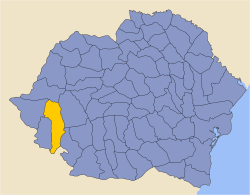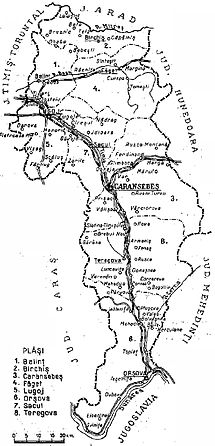Severin County
 From Wikipedia the free encyclopedia
From Wikipedia the free encyclopedia
Județul Severin | |
|---|---|
County (Județ) | |
 The Prefecture building of Severin County building of the interwar period. | |
 | |
| Country | |
| Historic region | Banat |
| Capital city (Reședință de județ) | Lugoj |
| Established | 1926 |
| Ceased to exist | Administrative and Constitutional Reform in 1950 |
| Area | |
| • Total | 6,422 km2 (2,480 sq mi) |
| Population (1930) | |
| • Total | 239,586 |
| • Density | 37/km2 (97/sq mi) |
| Time zone | UTC+2 (EET) |
| • Summer (DST) | UTC+3 (EEST) |

Severin County was a county (Romanian: județ) in the Kingdom of Romania, in the historical region of the Banat. Its capital was Lugoj. Severin County was established in 1926, disbanded with the administrative reform of 1938, re-created in 1940, and finally disbanded with the administrative reform of 1950.
Geography
[edit]Severin County covered 6,422 km2 (2,480 sq mi) and was located in the south-western part of Greater Romania, in the eastern part of the Banat. Currently, the territory that comprised Severin County is divided between Timiș, Caraș-Severin, Arad, and Mehedinți counties. In the interwar period, the county neighbored Caraș and Timiș-Torontal counties to the west, Arad County to the north, Hunedoara County to the east, Mehedinți County to the southeast, and the Kingdom of Yugoslavia to the south.
Administrative organization
[edit]Administratively, Severin County was originally divided into six districts (plăși): [1]
- Plasa Birchiș, headquartered at Birchiș
- Plasa Caransebeș, headquartered at Caransebeș
- Plasa Făget, headquartered at Făget
- Plasa Lugoj, headquartered at Lugoj
- Plasa Orșova, headquartered at Orșova
- Plasa Teregova, headquartered at Teregova
Subsequently, two more districts were established.
The county had three urban communes (cities): Lugoj (the county's headquarters), Caransebeș, and Orșova.
Population
[edit]According to the census data of 1930, the county's population was 239,586, which were ethnically divided as follows: 76.6% Romanians, 9.6% Germans, 6.6% Hungarians, 2.2% Romanies, as well as other minorities. From the religious point of view, the majority of the county population consisted of Eastern Orthodox (75.4%), followed by Roman Catholics (14.9%), Greek Catholics (3.9%), Reformed (3.1%), as well as other minorities.[2]
Urban environment
[edit]In 1930, the county's urban population was 40,456 inhabitants, ethnically 47.3% Romanians, 24.5% Germans, 16.8% Hungarians, 4.6% Jews, 3.1% Romanies, 1.2% Czechs and Slovaks, as well as other minorities. From the religious point of view, the urban population consisted of 46.4% Eastern Orthodox, 36.4% Roman Catholic, 4.9% Reformed, 4.8% Jewish, 4.1% Greek Catholic, 2.3% Lutheran, as well as other minorities.[2]
References
[edit]- ^ Portretul României Interbelice - Județul Severin
- ^ a b Recensământul general al populației României din 29 decemvrie 1930, Vol. II, pp. 722–725
External links
[edit]- (in Romanian) Severin County on memoria.ro

